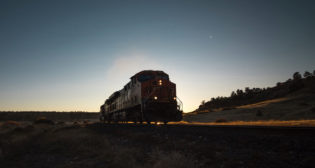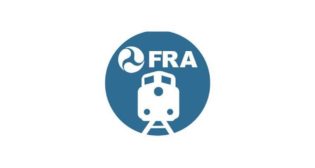
TSB cites lax Transport Canada oversight in Lac-Mégantic disaster
Written by David Thomas, Canadian Contributing EditorAside from advising Transport Canada to meet its responsibilities as national rail regulator, Canada’s Transportation Safety Board had just one new recommendation in its final investigation report: that parked locomotives trailing dangerous goods be secured by chocks, derailers, or advanced braking systems. Current regulation does not require the sort of physical restraint that would have prevented the Lac-Mégantic runaway.
The proximate causes identified by the TSB were poor locomotive maintenance and inadequate train securement, for which the safety board blames the now-defunct railway company (since taken over by Fortress Investment Group and re-started as the Central Maine & Quebec Railway).
The basic facts, said Transportation Safety Board Chair Wendy Tadros in releasing the final accident investigation report on August 19, 2014, are: “A crude oil train parked on a main track on a descending grade, with the lead locomotive running and seven hand brakes set. A fire begins in an engine that had been causing problems for days. Emergency responders shut off the engine, but then the air holding the locomotive brakes leaks off. Without enough force from the hand brakes, the train begins its tragic descent downhill.”
But, Tadros continued, employee responsibility is the last line of defense in railway safety, and not one that can substitute for management supervision and government oversight. MM&A was weakly managed, she said, and the federal regulator did little to police it:
“This was a company with a weak safety culture, a company where people did what was needed to get the job done, rather than always follow the rules,” Tadros said. “A company where unsafe conditions and unsafe practices were allowed to continue. Which begs a question: Who, then, was in a position to check on this company—to make sure safety standards were being met? Who was the guardian of public safety? That’s the role of government—to provide checks and balances. Oversight. And yet this booming industry—where unit trains were shipping more and more oil across Canada, and across the border—ran largely un-checked. Yes, Transport Canada knew about some of the problems at MM&A, but the follow-up wasn’t always there.”
TSB investigators released their report at the scene of the tragedy in which 47 people were killed and 2,000 displaced from their homes. TSB was surprisingly bold in pointing the finger of blame at Transport Canada, the Canadian government’s transportation regulator. Like the Federal Railroad Administration in the U.S., Transport Canada is part of the country’s executive branch, under the direct control of the governing party.
“If the guard dog doesn’t do its job, then indeed it is to blame,” said TSB Chief Operating Officer Jean Laporte when asked to say directly whether Transport Canada was the culprit-in-chief.
“There has to be a change in the Canadian railway industry,” said Tadros. “The increase in moving shipments of oil by rail took many by surprise, including the regulator. This accident will bring about a sea change in thinking by the railway industry, the shippers, and the regulators.”
The TSB had earlier issued emergency interim recommendations governing railway operations, each of which was rapidly implemented by a chastened Transport Canada, which previously had been slammed in separate reviews for not doing its job by the country’s auditor general and by its information commissioner for its regime of secrecy and obstruction of freedom of information legislation. The interim recommendations included enhanced standards for DOT-111 tank cars, requirements for railways to conduct safety-driver route planning and for Emergency Response Assistance Plans to be developed for the rail transportation of liquid hydrocarbons. Each of those recommendations was subsequently adopted by Transport Canada.
The TSB final report contains only two additional recommendations, the first that Transport Canada actually audit and inspect implementation of the “safety management systems” introduced in 2001 when direct government rulemaking was replaced by self-regulation. The TSB’s only new operational recommendation is that Canada adopt recent U.S. National Transportation Safety Board advice that trains parked on main line grades be restrained by derailers or other physical devices.
“Transport Canada must require railways to put in place additional physical defenses to prevent runaway trains,” said Tadros. “This could mean things like wheel chocks, or modern braking technology, because right now, Transport Canada is relying on the rules that still allow a train carrying dangerous goods to be left unattended on a descending grade.”
Despite the earlier focus on misclassified oil and inadequate tank cars, the TSB final report made no mention of whether changes to tank car design or accurate cargo classification would have avoided the disaster. Nor would Donald Ross, the TSB’s chief investigator in the Lac-Mégantic event, say whether tank cars conforming to new regulatory standards could have prevented or mitigated the explosive consequences of the derailment.
TSB Chair Tadros concluded that the report will do nothing to console survivors, but hoped that it would reassure Canadians that crude-hauling trains will become safe enough to transit an area of dense population. “For the people of Lac-Mégantic, today’s report won’t do anything to bring back their loved ones, or to rebuild their town,” he said. “We know that. But we can point the way toward a better future, a safer future. One where the trains that travel through our cities—and through our towns—are no longer feared.”



